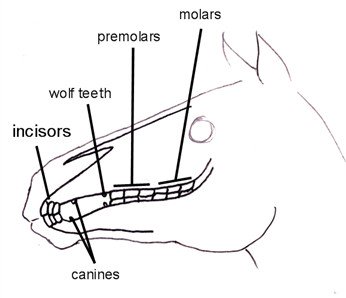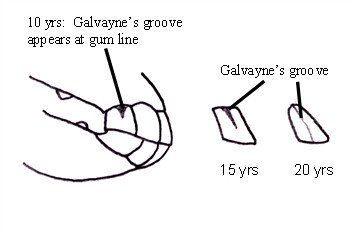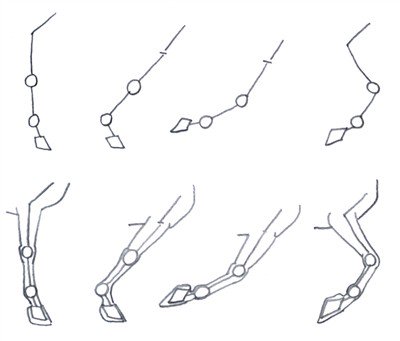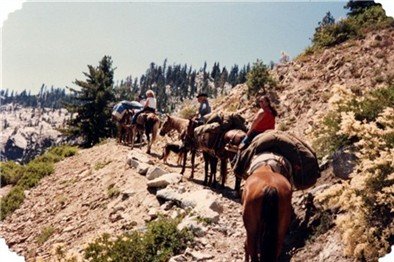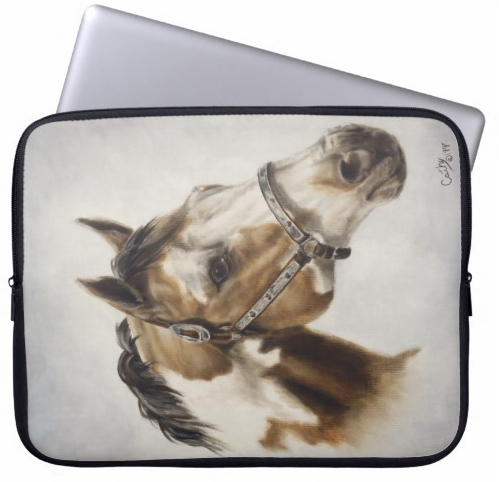Horse Teeth - Age, Anatomy and Growth
Horse teeth continue to grow for the life of the horse. Because of this continual growth it is necessary that horses receive regular dental care with a procedure called floating. Floating teeth keeps the grinding surfaces even, ensuring proper food digestion.
The changes that take place to the horse’s teeth over time help determine the age of a horse. Aging a horse by its teeth is very accurate in young horses and during specific time periods in a horse’s life. As the horse grows older, this tooth aging process becomes less accurate.
The teeth are made up of materials that vary in hardness. This variation causes portions of the teeth to wear at different rates. The combination of wear marks, the presence or absence of baby teeth, tooth shape, and identifying grooves all help in aging a horse by its teeth.
Horse Teeth and Age
- 1 yr: have 24 baby teeth
- 2- 2½ yrs: will have second set of permanent molars
- 3 yrs: 2 permanent central incisors erupted
- 4 yrs: canine teeth erupted (males and some mares)
- 5 yrs: all permanent teeth are in, grinding surfaces are oval from side to side
- 6 yrs: permanent incisors showing wear
- 7 and 8 yrs: cups of the middle, lower incisors disappear
- 8 and 9 yrs: cups of the corner, lower incisors disappear
- 10 yrs: Galvayne’s groove appears at gum line
- 11 yrs: cups in corner, upper incisors disappear
- 12 yrs: chewing surfaces on central incisors become round instead of oval
- 14-16 yrs: corner incisors develop ridges
- 17 yrs: all incisors have round surface
- 18 yrs: central incisors become triangular
- 20 yrs: Galvayne’s groove runs the length off the corner incisors
- 23 yrs: all incisors become triangular
- 24 to 29 yrs: The grinding surfaces become oval again, but this time from front to back
- 30 yrs: Galvayne’s groove gone
- Over 30+ yrs: short teeth, small tooth nubs, loss of teeth
An adult horse has 36 teeth: 12 incisors, 12 premolars and 12 molars.
A foal will have 24 teeth: 12 incisors and 12 premolars.
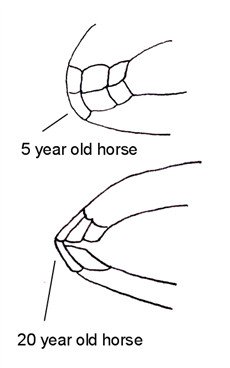
He may also have up to 4 wolf teeth and a set of 4 canine teeth. The wolf teeth come in at about 5 to 6 months of age. These are the small pointed teeth that grow in just in front of the premolars. Wolf teeth are often shed along with the baby teeth, but not always. If the wolf teeth are retained and interfere with the bit they can be removed. The horse does not need them for chewing.
Most male horses will have canine teeth and some mares will too. If a horse grows canine teeth they will erupt at about 4 years of age. These small pointed teeth grow just a little bit behind the incisors on the bars of the horse’s mouth. They generally do not interfere with the bit.
A foal will have grown his first 24 baby teeth, deciduous teeth, by nine months. By 12 months he will grow his first set of permanent molars. It will take four to five years for a young horse to loose all his baby teeth and replace them with the permanent adult horse teeth.
Anatomy of Horse Teeth
A horse’s tooth has a very long root that resides deep into the jaw bone. Very slowly over time tooth grows (pushes out). A very young horse will have a small bit of tooth exposed with a long root. A very old horse will have a small bit of tooth exposed with hardly any root left; as they have ‘used their tooth up’ over time.
The permanent teeth change shape as the horse grows older, because what you are seeing is the ‘root’ portion of the tooth that is slowly emerging from the jaw.
The front teeth, or incisors, are used for biting grass. The back teeth, molars and premolars, are used for grinding the grass. The horse has a large inter-dental space between the incisors and the molars. That’s a fancy term for what we call the bars, the space in the horses gums that have no teeth at all.
A young horse’s teeth will be shorter and straight up and down. The older a horse gets, the longer the tooth becomes, giving rise to the term “Long in the tooth.” The incisors become longer and more and more slanted at a forward angle as the horse ages.
Horse Teeth and the Galvayne’s Groove
At about the age of 10, the upper corner incisors begin to show a groove at the gum line. This is the Galvayne’s groove. Over the next 10 years the groove will grow all the way down the length of the tooth. A 20 year old horse will have a Galvayne’s groove all the way down the upper corner incisors.
Then the groove begins to disappear, starting from the top. By the time the horse is 30 the groove will be completely gone. Eventually those long incisors will grow very short as the old horse has very little tooth left.
Wouldn't it be nice to have a detailed horse teeth chart right in the barn where you need it? Check this one out!
More Topics You May Enjoy
Draw Horse Legs
How to Draw Horses - The Legs. Learn how to draw horses legs the easy way. It’s simple and anyone can do it. Once you understand how a horse bends and moves those long beautiful legs, you’ll be drawing them like a pro.
Horse First Aid Kit
Find out what items you need to build a well rounded horse first aid kit for your barn, your truck and on the trail.
Shop Horse Lovers Gifts
Find fun and functional gifts for horse lovers inspired by the art work of Cathy Cleveland.
